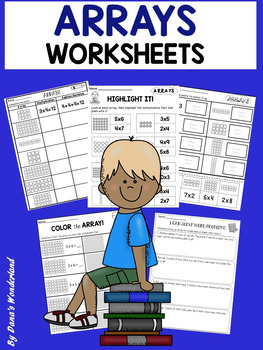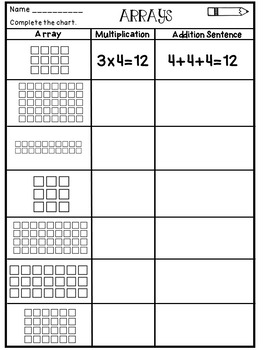2nd-3rd Grade Multiplication Arrays Worksheets with Repeated Addition
Dana's Wonderland
12.6k Followers
Grade Levels
2nd - 3rd
Subjects
Resource Type
Standards
CCSS2.OA.C.4
CCSS3.OA.A.1
CCSS3.OA.A.3
Formats Included
- PDF
- Easel Activity
Pages
26 pages
Dana's Wonderland
12.6k Followers
Easel Activity Included
This resource includes a ready-to-use interactive activity students can complete on any device. Easel by TPT is free to use! Learn more.
What educators are saying
I love this resource. It was easy to follow. It was an easy download with no problems. My students were able to understand it. It really helped my kids’ understanding. It also helped me a whole lot with planning !!! Definitely buy this resource. It is amazing!!!
Fantastic resource to introduce arrays for a multiplication unit. My students loved these handouts to work on and practice arrays! Thank you so much!
Description
Are you teaching multiplication arrays to your students? This resource contains FUN and ENGAGING multiplication worksheets that focus on multiplying with arrays using repeated addition. These practice sheets are ideal for morning work, centers, or homework!
Types of worksheets included:
* Highlight the multiplication fact that goes with each array.
* Cut and paste to match each array with the corresponding multiplication fact or repeated addition.
* Color the array to show the multiplication fact.
* Complete the chart: array, multiplication sentence, repeated addition sentence.
* Solve word problems by using arrays.
Happy teaching!
Dana's Wonderland
Total Pages
26 pages
Answer Key
N/A
Teaching Duration
N/A
Report this resource to TPT
Reported resources will be reviewed by our team. Report this resource to let us know if this resource violates TPT’s content guidelines.
Standards
to see state-specific standards (only available in the US).
CCSS2.OA.C.4
Use addition to find the total number of objects arranged in rectangular arrays with up to 5 rows and up to 5 columns; write an equation to express the total as a sum of equal addends.
CCSS3.OA.A.1
Interpret products of whole numbers, e.g., interpret 5 × 7 as the total number of objects in 5 groups of 7 objects each. For example, describe a context in which a total number of objects can be expressed as 5 × 7.
CCSS3.OA.A.3
Use multiplication and division within 100 to solve word problems in situations involving equal groups, arrays, and measurement quantities, e.g., by using drawings and equations with a symbol for the unknown number to represent the problem.






